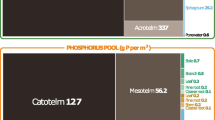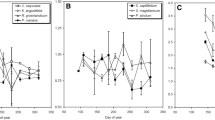Abstract
An understanding of the mechanisms controlling nutrient availability and retention in and across ecosystems allows for a greater understanding of the role of nutrients in maintaining ecosystem structure and function. To examine the underlying mechanisms of phosphorus (P) cycling in northern peatlands, we compared the retention and movement of P across a natural hydrologic/pH gradient in nine peatlands by applying as a light rain an in situ tracer amount of 32PO4 −3 to track changes in P pools (vegetation, soil, microbial) over 30 days. The 31P concentrations of available P, microbial P, and the root P at 10–20 cm did not differ across the gradient, although total soil P and aboveground vegetation P content (μg m−2) increased from bog to rich fen. Total retention of 32P in the first 24 hours of application was greatest in the bogs and intermediate fens (90–100%) and was very low (20–50%) in the rich fens. Retention of P in the different pools was dependent on the type of peatland and changed with time. In the first 24 hours in the bogs and intermediate fens, the microbial pool contained the largest amount of 32P, but by the seventh day, the aboveground vegetation contained the largest amount. In the rich fen, the recovered 32P was almost equally divided between the aboveground vegetation and the litter layer with very little in other pools. Therefore, although bogs and intermediate fens have a small total P pool, they have similar P availability to rich fens because of rapid cycling and efficient retention of P.
Similar content being viewed by others
References
Aerts R. 1999. Interspecific competition in natural plant communities: mechanisms, trade-offs and plant-soil feedbacks. Journal of Experimental Botany 50: 29–37.
Bedford B.L., Walbridge M.R. and Aldous A. 1999. Patterns in nutrient availability and plant diversity of temperate North American wetlands. Ecology 80: 2151–2169.
Berg B. and Tamm C.O. 1991. Decomposition and nutrient dynamics of litter in log-term optimum nutrition experiments. I. Organic matter decomposition in Picea abies needle litter. Scandinavian Journal of Forest Research 6: 305–321.
Bowden W.B. 1987. The biogeochemistry of nitrogen in freshwater wetlands. Biogeochemistry 4: 313–348.
Bridgham S.D., Updegraff K. and Pastor J. 2001. A comparison of nutrient availability indices along an ombrotrophic-minerotrophic gradient in Minnesota wetlands. Soil Sci. Soc. of Am. J. 65: 259–269.
Bridgham S.D., Updegraff K. and Pastor J. 1998. Carbon, nitrogen, phosphorus mineralization in northern wetlands. Ecology 79: 1545–1561.
Bridgham S.D., Pastor J., Janssens J.A., Chapin C.T. and Malterer J. 1996. Multiple limiting gradients in peatlads: A call for a new paradigm. Wetlands 16: 45–65.
Brookes P.C., Powlson D.S. and Jenkinson D.S. 1984. Phosphorus in the soil microbial biomass. Soil Biology and Biochemistry 16: 169–175.
Chapin C.T. 1998. Plant community response and nutrient dynamics as a result of manipulations of pH and nutrients in a bog and fen in northeastern Minnesota. PhD Dissertation, University of Notre Dame, Notre Dame, USA.
Chapin F.S. III and Van Cleve K. 1994. Approaches to studying nutrient uptake, use and loss in plants. In: Pearcy R.W., Ehleringer J., Mooney H.A. and Rundel P.W. (eds), Plant Physiological Ecology. Chapman and Hall, London.
Chapin F.S. III, Barsdale R.J. and Barel D. 1978. Phosphorus cycling in Alaska coastal tundra: a hypothesis for the regulation of nutrient cycling. Oikos 31: 188–199.
Chiang C., Craft C.B., Rogers D.W. and Richardson C.J. 2000. Effects of 4 years of nitrogen and phosphorus additions on Everglades plant communities. Aquatic Botany 68: 61–78.
Clymo R.S. and Hayward P.M. 1982. Chapter 8: The ecology of Sphagnum. In: Smith A.J.E. (ed.), Bryophyte Ecology. Chapman & Hall, London.
Craft C.B. and Richardson C.J. 1997. Relationship between soil nutrients and plant species composition in Everglades peatlands. J. Environ. Qual. 26: 224–232.
Damman A.W.H. 1986. Hydrology, development and biogeochemistry of ombrogenous peat bogs with special reference to nutrient allocations in a western Newfoundland bog. Can. J. Bot. 64: 384–394.
Damman A.W.H. 1988. Regulation of nitrogen removal and retention in Sphagnum bogs and other peatlands. Oikos 51: 291–305.
Davis S.M. 1989. Sawgrass and cattail production in relation to nutrient supply in the Everglades. In: Sharitz R.R. and Gibbins J.W. (eds), Freshwater Wetlands and Wildlife. CONF-8603101, DOE symposium series no. 61. USDOE Office of Scientific and Technical Information, Oak Ridge, TN, USA.
Fauci M.F. and Dick R.P. 1994. Soil microbial dynamics: Short-and long-term effects of inorganic and organic nitrogen. Soil Sci. Soc. Am. J. 58: 801–806.
Golterman H.L. 1995. The labyrinth of nutrient cycles and buffers in wetlands: results based on research in the Camargue (southern France). Hydrobiologia 315: 39–58.
Håland B. and Brække F.H. 1989. Distribution of root biomass in a low-shrub pine bog. Scand. J. of Forest Research 4: 307–316.
Hedin L.O., von Fischer J.C., Ostrom N.E., Kennedy B.P., Brown M.G. and Robertson G.P. 1998. Thermodynamic constraints on nitrogen transformations and other biogeochemical processes at soilstream interfaces. Ecology 79: 684–703.
Hedin L.O., Armesto J.J. and Johnson A.H. 1995. Patterns of nutrient loss from unpolluted old-growth temperate forests: Evaluation of biogeochemical theory. Ecology 76: 493–509.
Hogg E.H. 1993. Decay potential of hummock and hollow Sphagnum peats at different depths in a Swedish raised bog. Oikos 66: 269–278.
Jayachandran K., Schwab A.P. and Hetrick B.A.D. 1992. Partitioning dissolved inorganic and organic phosphorus using acidified molybdate and isobutanol. Soil Science Society of America Journal 56: 762–765.
Jonasson S., Michelsen A., Schmidt I.K. and Nielsen E.V. 1999. Responses in microbes and plants to changed temperature, nutrient, and light regimes in the arctic. Ecology 80: 1828–1843.
Lowther J.R. 1980. Use of a single sulfuric acid and hydrogen peroxide digest for the analysis of Pinus radiata needles. Comm. Soils Sci. Plant Analysis 11: 1785–1788.
Malmer N. 1993. Mineral nutrients in vegetation and surface layers of Sphagnum-dominated peat-forming systems. Adv. Bryology. 5: 223–248.
Megonigal J.P. and Day F.P. 1992. Effects of flooding on root and shoot production of bald cypress in large experimental enclosures. Ecology 4: 1182–1193.
Moore P.D. and Bellamy D.J. 1974. Peatlands. Springer-Verlag, New York, NY, USA.
Olsen S.R. and Sommers L.E. 1982. Phosphorus. In: Miller R.H. and Keeney D.R. (eds), Methods of Soil Analysis. Part 2. Chemical and Microbiological Properties. 2nd edn. American Society of Agronomy, Madison, WI, USA, pp. 403–430.
Pomeroy L.R. 1970. The strategy of mineral cycling. Annu. Rev. of Ecol. Syst. 1: 171–190.
Redfield G.W. 1998. Quantifying atmospheric deposition of phosphorus: a conceptual model and literature review for environmental management. Technical publication WRE #360. South Florida Water Management District, West Palm Beach, FL, USA.
Richardson C.J. and Marshall P.E. 1986. Processes controlling movement, storage, and export of phosphorus in a fen peatland. Ecological Monographs 56: 279–302.
Richardson C.J. and Qian S.S. 1999. Long-term phosphorus assimilative capacity in freshwater wetlands: A new paradigm for sustaining ecosystem structure and function. Environ. Sci. Technol. 33: 1545–1551.
Runge M. 1983. Chapter 5: Physiology and Ecology of Nitrogen Nutrition. In: Lange O.L., Nobel P.S., Osmond C.B. and Ziegler H. (eds), Physiological Plant Ecology III: Response to the chemical and biological environment. Springer-Verlag, Berlin, pp. 163–200.
Small E. 1972. Photosynthetic rates in relation to nitrogen recycling as an adaptation to nutrient defi-ciency in peat bog plants. Canadian Journal of Botany. 50: 2227–2233.
Susuki A.K., Lawton K. and Doll E.C. 1963. Phosphorus uptake and soil tests as related to forms of phosphorus in some Michigan soils. Soil Sci. Soc. Am. J. 31: 752–756.
Szumigalsky A.R. and Bayley S.E. 1996. Net above-ground primary production along a bog-rich fen gradient in central Alberta, Canada. Wetlands 4: 467–476.
Updegraff K., Pastor J., Bridgham S.D. and Johnson C.A. 1995. Environmental and substrate controls over carbon and nitrogen mineralization in northern wetlands. Ecological Applications 5: 151–163.
van Breemen N. and Finzi A.C. 1998. Plant-soil interactions: ecological aspects and evolutionary implications. Biogeochemistry 42: 1–19.
van Bruggen A.H.C., Semenov A.M. and Zelenev V.V. 2000. Wavelike distributions of microbial populations along an artificial root moving through soil. Microbial Ecology 40: 250–259.
Verhoeven J.T.A., Maltby E. and Schmitz M.B. 1990. Nitrogen and phosphorus mineralization in fens and bogs. Journal of Ecology 78: 713–726.
Vermeer J.G. and Berendse F. 1983. The relationship between nutrient availability, shoot biomass and species richness in grassland and wetland communities. Vegetatio 53: 121–126.
Vitt D.H. 1990. Growth and production dynamics of boreal mosses over climatic, chemical and topographic gradients. Botannical Journal of the Linnean Society 104: 35–59.
Vitousek P.M. and Howarth R.W. 1991. Nitrogen limitation on land and in the sea: How can it occur? Biogeochemistry 13: 87–115.
Vitousek P.M. and Matson P.A. 1991. Gradient Analysis of Ecosystems. In: Cole J., Lovett G. and Findlay S. (eds), Comparative Analyses of Ecosystems: Patterns, mechanisms, and theories. Springer-Verlag, New York, NY, USA, pp. 287–297.
Vitousek P.M., Aber J.D., Howarth R.W., Likens G.E., Matson P.A., Schindler D.W. et al. 1997. Human alteration of the global nitrogen cycle: Sources and consequences. Ecological Applications 7: 737–750.
Walbridge M.R. 1991. Phosphorous availability in acid organic soils of the lower North Carolina coastal plain. Ecology 72: 2083–2100.
Walbridge M.R. and Struthers J.P. 1993. Phosphorus retention in non-tidal palustrine forested wetlands of the mid-Atlantic region. Wetlands 13: 84–94.
Walbridge M.R. and Vitousek P.M. 1987. Phosphorus mineralization potentials in acid organic soils: Processes affecting 32PO4 -3 isotope dilution measurements. Soil Biol. Biochem. 19: 709–717.
Waughman G.J. 1980. Chemical aspects of the ecology of some south German peatlands. Journal of Ecology 68: 1025–1046.
Wilson K.A. and Fitter A.H. 1984. The role of phosphorus in vegetational differentiation in a small valley mire. Journal of Ecology 72: 463–473.
Zar J.H. 1996. Biostatistical Analysis. Prentice Hall, Upper Saddle River, NJ, USA.
Rights and permissions
About this article
Cite this article
Kellogg, L.E., Bridgham, S.D. Phosphorus retention and movement across an ombrotrophic-minerotrophic peatland gradient. Biogeochemistry 63, 299–315 (2003). https://doi.org/10.1023/A:1023387019765
Issue Date:
DOI: https://doi.org/10.1023/A:1023387019765




